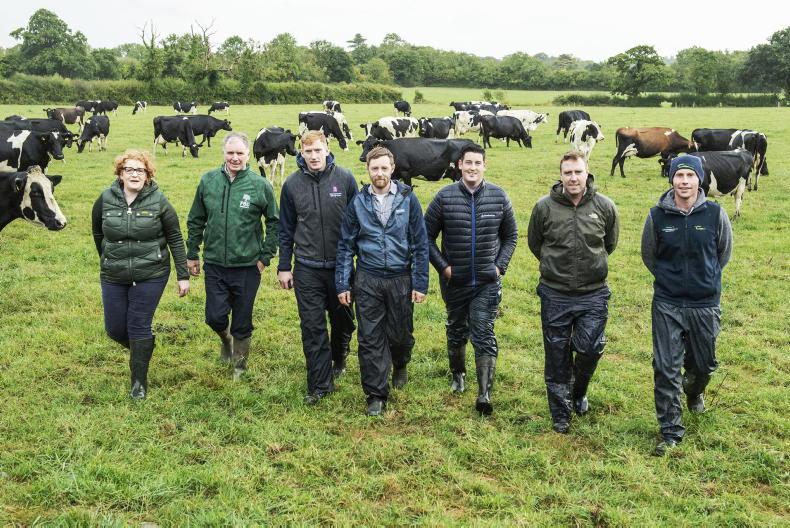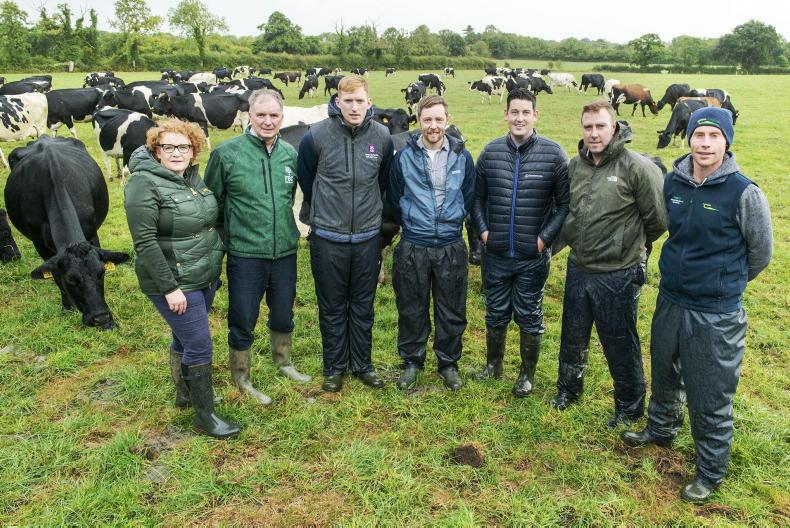Milking 220 cows on an 81ha milking platform just outside Adare, Colin Doherty’s plans to build up a good stock of grass for the autumn went out the window with the prolonged dry spell in July and August.
The average farm cover on the milking platform went as low as 180kg/ha, but with 31ha of an outfarm with no stock on it, the overall farm cover including this outblock is 400kg/ha.
Colin’s plan is to close the farm up with an average farm cover of 800kg/ha in early December, with cows ceasing grazing in mid-November.
In order to get to this point, he needs the farm to start growing well over the rest of September and into October.
We have the option of continuing to feed the zero grazed grass or silage for longer, which will reduce the demand for grass
In his autumn grass budget on PastureBase, Colin is predicting a peak growth rate of 60kg/day in late September, which some members of the audience felt was a bit too optimistic.
Teagasc adviser Tim Doody, speaking on the grass stand, said that the pattern of rain this year was very similar to that of 1995, when growth rates peaked at 40kg/day.
Grass budget can be tweaked
Colin said that the beauty of the grass budget is that it can be tweaked depending on growth rates each week.
“There are a few things we can do. Firstly, we can sell the cull cows a bit earlier than planned. There are some cows due to go next week, but the main lot of culls aren’t due to leave until October.

Pictured at the Teagasc Grass10 open day on the farm of 2021 Grassland Farmer of the Year Colin Doherty, Graigue Farm, Adare, Co Limerick are Majella Moloney, Teagasc regional manager Kerry/Limerick, Richard Lanigan, FBD, Shane McCarthy, AIB, host Colin Doherty, John O'Loughlin, Grassland Agro, Aidan Brennan, Irish Farmers Journal and Joseph Dunphy, Teagasc Grass10. \ O'Gorman Photography.
“The other thing we can do is adjust the feed rates. As things stand, we are planning on feeding 3kg of meal per cow per day for the rest of the year and feed 5kg of zero grazed grass up until October.
“We have the option of continuing to feed the zero grazed grass or silage for longer, which will reduce the demand for grass. The final option available to us is to cull the low-yielding heifers sooner,” Colin said.
Colin’s herd of Jersey crossbred cows delivered 436kg MS/cow in 2021 and because the herd has been growing, half the cows are in either first or second lactation.
Colin says he’s not chasing output and instead is happier to focus on providing good-quality grass at low cost and making sure cows are well fed.
The heifers on the Doherty farm are contract reared and Colin plans to increase cow numbers to 270 over the coming years, which will be an overall stocking rate of 2.4 cows/ha and 3.2 cows/ha on the milking platform.
Milking 220 cows on an 81ha milking platform just outside Adare, Colin Doherty’s plans to build up a good stock of grass for the autumn went out the window with the prolonged dry spell in July and August.
The average farm cover on the milking platform went as low as 180kg/ha, but with 31ha of an outfarm with no stock on it, the overall farm cover including this outblock is 400kg/ha.
Colin’s plan is to close the farm up with an average farm cover of 800kg/ha in early December, with cows ceasing grazing in mid-November.
In order to get to this point, he needs the farm to start growing well over the rest of September and into October.
We have the option of continuing to feed the zero grazed grass or silage for longer, which will reduce the demand for grass
In his autumn grass budget on PastureBase, Colin is predicting a peak growth rate of 60kg/day in late September, which some members of the audience felt was a bit too optimistic.
Teagasc adviser Tim Doody, speaking on the grass stand, said that the pattern of rain this year was very similar to that of 1995, when growth rates peaked at 40kg/day.
Grass budget can be tweaked
Colin said that the beauty of the grass budget is that it can be tweaked depending on growth rates each week.
“There are a few things we can do. Firstly, we can sell the cull cows a bit earlier than planned. There are some cows due to go next week, but the main lot of culls aren’t due to leave until October.

Pictured at the Teagasc Grass10 open day on the farm of 2021 Grassland Farmer of the Year Colin Doherty, Graigue Farm, Adare, Co Limerick are Majella Moloney, Teagasc regional manager Kerry/Limerick, Richard Lanigan, FBD, Shane McCarthy, AIB, host Colin Doherty, John O'Loughlin, Grassland Agro, Aidan Brennan, Irish Farmers Journal and Joseph Dunphy, Teagasc Grass10. \ O'Gorman Photography.
“The other thing we can do is adjust the feed rates. As things stand, we are planning on feeding 3kg of meal per cow per day for the rest of the year and feed 5kg of zero grazed grass up until October.
“We have the option of continuing to feed the zero grazed grass or silage for longer, which will reduce the demand for grass. The final option available to us is to cull the low-yielding heifers sooner,” Colin said.
Colin’s herd of Jersey crossbred cows delivered 436kg MS/cow in 2021 and because the herd has been growing, half the cows are in either first or second lactation.
Colin says he’s not chasing output and instead is happier to focus on providing good-quality grass at low cost and making sure cows are well fed.
The heifers on the Doherty farm are contract reared and Colin plans to increase cow numbers to 270 over the coming years, which will be an overall stocking rate of 2.4 cows/ha and 3.2 cows/ha on the milking platform.







 This is a subscriber-only article
This is a subscriber-only article









SHARING OPTIONS: